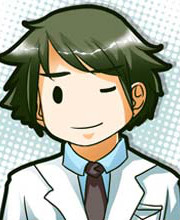| 图片: | |
|---|---|
| 名称: | |
| 描述: | |
- B4038右侧阴囊包块
| 性别 | 女 | 年龄 | 60 | 临床诊断 | 右侧阴囊包块 |
|---|---|---|---|---|---|
| 一般病史 | 右侧阴囊包块渐赠大 | ||||
| 标本名称 | 右侧阴囊包块 | ||||
| 大体所见 | 囊性肿物一个,体积11.5x6x5cm,切面鞘膜内含有淡黄色液体,睾丸及附睾结构不清,体积约11x5x4.5cm,切面囊状,内含粘液胶冻样物,内壁尚光滑,局部少粗糙,内壁上可见少量毛发样物,内壁并见一头节,体积1.5x1x1cm, 内有钙化 | ||||

名称:图1
描述:0

名称:图2
描述:1

名称:图3
描述:2

名称:图4
描述:3

名称:图5
描述:4

名称:图6
描述:5

名称:图7
描述:6

名称:图8
描述:7

名称:图9
描述:8

名称:图10
描述:9

名称:图11
描述:10

名称:图12
描述:11

名称:图13
描述:12

名称:图14
描述:13
图3-12可见上皮有增生,不典型增生,除头节处可见外胚层及中胚层结构,其余囊壁大部分为粘液性上皮,有睾丸畸胎瘤合并囊腺瘤的吗?不够诊断恶性的吧?
-
本帖最后由 yangjinfeng0929 于 2013-03-15 19:35:11 编辑
-
本帖最后由 红胜火 于 2013-04-04 21:51:26 编辑
大家都认为是畸胎瘤,我想是把卵巢畸胎瘤的概念想当然地应用于睾丸,但睾丸却比较特殊。楼主提的有毛发结构,现在所有的文献中均提到睾丸的畸胎瘤看不到,至少目前还没有存在毛发的病例报道。加之楼主描述似乎是单囊,有头节,所以这一例需要鉴别皮样囊肿。请大家注意的是,睾丸的皮样囊肿和我们的一般理解不同,它可以有内胚层成分如肠上皮,可以有中胚层成分如软骨,当然它一定有外胚层成分皮肤组织。
为什么一定区分?
正如很多网友提到的,成人睾丸的畸胎瘤都是恶性的,有转移能力。但皮样囊肿无转移能力,在皮样囊肿中发生的癌的情况如何?我们现在还不知道。这一例的有意思的地方就在这里。
-
babycat_mm 离线
- 帖子:29
- 粉蓝豆:107
- 经验:61
- 注册时间:2011-11-13
- 加关注 | 发消息
-
benben520sps 离线
- 帖子:1045
- 粉蓝豆:568
- 经验:1254
- 注册时间:2009-07-28
- 加关注 | 发消息
-
kuhaitianxin 离线
- 帖子:1570
- 粉蓝豆:51
- 经验:1661
- 注册时间:2010-10-16
- 加关注 | 发消息
-
本帖最后由 红胜火 于 2013-04-04 21:49:52 编辑
| TERATOMA VERSUS DERMOID CYST AND EPIDERMOID CYST |
Epidermoid
cysts are relatively uncommon, and dermoid cysts are rare. Both need to be
distinguished from the usual teratoma of the adult testis because they are
uniformly benign, whereas the usual postpubertal teratoma may have associated
metastases of either teratomatous or nonteratomatous germ cell tumors.43,44 We feel that
dermoid cysts likely develop from benign germ cells with retained embryonic
properties, probably similar to prepubertal testicular teratomas and ovarian
teratomas. Epidermoid cysts either have a similar histogenesis or may possibly
arise from displaced metaplastic mesothelial cells. Usual testicular teratoma
of the postpubertal type, in contrast, develops from malignant germ cells
(IGCNU), usually indirectly, by differentiation from other types of invasive
germ cell tumors. It, therefore, represents a differentiated, malignant
neoplasm that forms through a process of “maturation” from more primitive types
of germ cell tumors.
Grossly, dermoid cysts and epidermoid cysts are unilocular cystic masses filled with keratinous material that may have a laminated appearance (Figure 3, A). Dermoid cyst may have a mural protuberance in the wall and contain hair. In comparison, teratoma often presents as a multilocular solid-cystic complex mass, and we have never grossly identified hair in a usual teratoma of the adult testis. Microscopically, a dermoid cyst is lined by squamous epithelium and skin adnexal structures (Figure 3, B). Prominent lipogranulomas may be seen in the testis, presumably as a reaction to sebaceous material leaked from the cyst contents (Figure 3, C). In addition to the cutaneous-type components, dermoids may have components of other tissues, including glandular elements, adipose tissue, cartilage (Figure 3, B), and bone, further mimicking postpubertal teratoma.45 An epidermoid cyst is a simple cyst lined by squamous epithelium, with no adnexal structures or other tissue types (Figure 3, D).46,47 In contrast, a teratoma often contains multiple cysts, lined by glandular or squamous epithelium, neuroectodermal tissue, noncystic glands, and mesenchymal tissues, such as adipose tissue and cartilage (Figure 3, E). A critical feature of both dermoid and epidermoid cysts, which distinguishes them from the usual teratoma, is the absence of IGCNU in the adjacent testis (Figures 3, C and D), whereas IGCNU occurs with a usual teratoma in 90% of the cases (Figure 3, F).48 Extreme care is needed when diagnosing dermoid cyst or epidermoid cyst in postpubertal testes. The presence of IGCNU (or other germ cell tumor elements) excludes a dermoid cyst and an epidermoid cyst and indicates that the lesion is a usual teratoma. Additional helpful features that aid in the distinction of the dermoid cyst from the usual teratoma include the presence in a usual teratoma of cytologic atypia of its elements and associated testicular atrophy with impaired spermatogenesis. Dermoid cysts lack cytologic atypia, and in most cases, the adjacent testis has a normal appearance with active spermatogenesis (Figure 3, C), although there may be compressive atrophy in the parenchyma immediately adjacent to the cyst. Isochromosome 12p by cytogenetic studies can be confirmatory in difficult cases. It is present in most postpubertal teratomas, but not epidermoid cysts.49 Based on light microscopic observations of dermoid cysts, we anticipate that they would also lack i(12p) or other forms of 12p amplification, but that has not, to our knowledge, been studied yet. As a general marker for TGCT, SALL4 is frequently expressed in teratoma,41 but its expression in dermoid and epidermoid cysts is, to our knowledge, unknown.

Figure3. A, The cut surface of an epidermoid cyst frequently shows laminatedwhite-yellow material. B, A dermoid cyst, by definition, forms skinlikestructures with adnexal elements. Other tissue types, however, may also beseen, including cartilage. C, Lipogranulomas (right) and normal spermatogenesiswithout intratubular germ cell neoplasia are seen adjacent to a dermoid cyst.D, An epidermoid cyst is lined by keratinizing squamous epithelium withoutadnexal structures (top). The adjacent tubules show normal spermatogenesiswithout intratubular germ cell neoplasia. E, Most usual teratomas show ahaphazard arrangement of various tissues, including glands, squamousepithelium, and cartilage. F, Intratubular germ cell neoplasia, unclassifiedtype, has a basilar arrangement of seminoma-like cells with Sertoli cells attheir luminal aspect in a tubule lacking spermatogenesis (hematoxylin-eosin,original magnifications ×40 [B and E], ×200 [C], ×100 [D], and ×600 [F]).
-
zq19931125 离线
- 帖子:681
- 粉蓝豆:4
- 经验:734
- 注册时间:2012-07-12
- 加关注 | 发消息




























